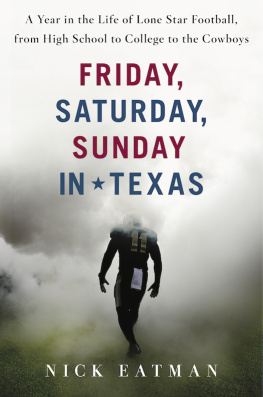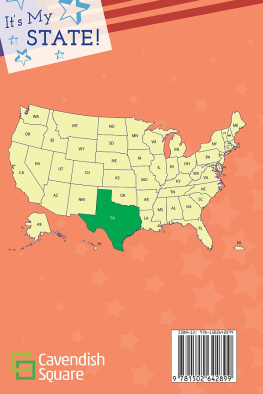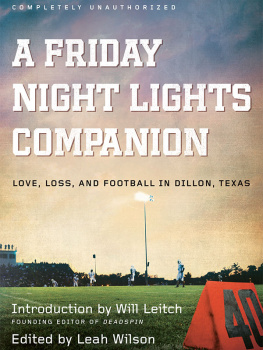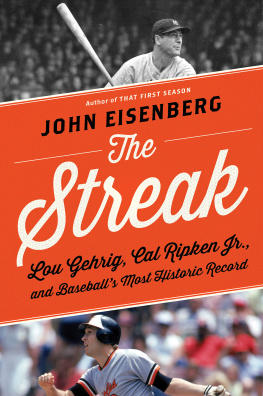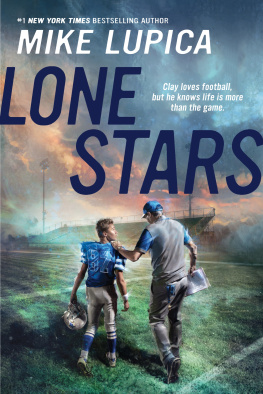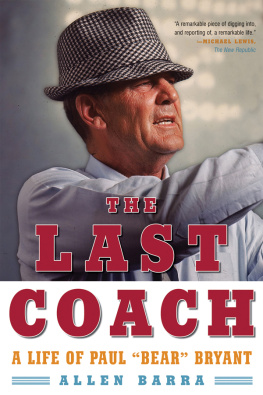

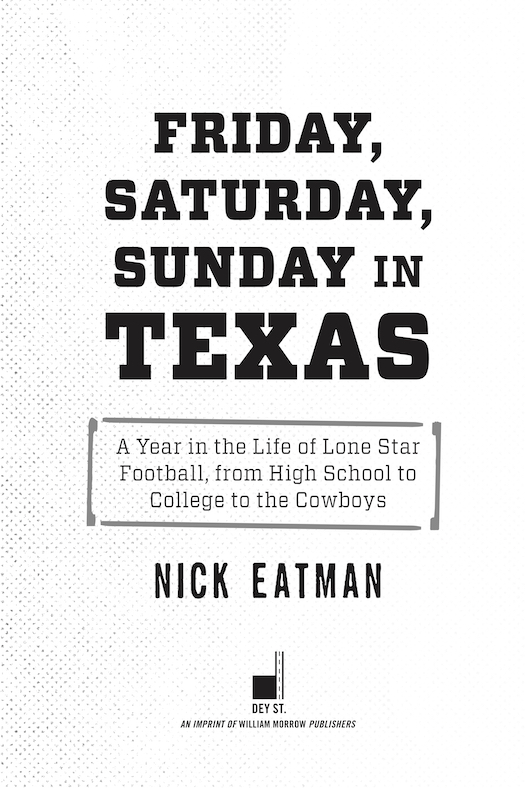
This book is dedicated to every raised eyebrow, every optimistic grin, and for anyone and everyone who told me this book was a great idea or something they couldnt wait to read. There were many long nights, bumps in the road from start to finish, but those encouraging words along the way from colleagues, friends, and certainly my family helped me push through to the end.
CONTENTS
In football, at any level, you never know what is going to happen. It doesnt matter if its high school, college, or the NFL, thats the beauty of the game, the frustration of it, and sometimes both at the same time.
Unpredictability is why we watch football; why we, as fans, stick around even when all signs point to the game being over. Its what happens just when you think you know the end of the story. Its what happens even when you think the end has already been written.
My unpredictable journey writing this book began long before the 2015 football season. The idea first began in the fall of 2013. I had just published a biography of Art Briles called Looking Up and was working on a collection of Dallas Cowboys stories titled If These Walls Could Talk, when my thoughts shifted to a possible third book.
But time was limited, especially since I was traveling around to promote the Baylor book in Waco on Saturday; attending every Cowboys game on Sunday, home and away; and then trying to squeeze in some Friday night high school action with the Plano Wildcats, a team I had followed over the years thanks to a couple of friends on the coaching staff.
One night around 11 p.m., though, while flipping through the channels on television, I found some unexpected inspiration. The show Modern Family has been one of my favorites, and I have seen dozens of episodes. But on this night, as I watched the episode bounce back and forth between three different families and three different sets of issues, yet all seemingly wanting the same goal for each other it hit me.
Right then and there is where this idea first popped into my head: I wanted to write a book on the three levels of football in Texas, showing just how different, yet similar, the sport can be when its played for the most passionate football fans in the country. Whether its the high schooler preparing for his SAT test, the college kid studying for his next trigonometry exam, or a rookie linebacker for the Cowboys digging into his playbook for an upcoming game against the Washington Redskins, there are parallels, problems, and plays that speak to every level of the game.
Obviously, the interest in high school, college, and pro football is vastly different. Only a handful of high school games are ever televised during the regular season. Conversely, just a few games in big-time college football are played without TV exposure, and in the NFL, fans now have the ability to watch every game coast to coast.
Still, no matter the day, no matter the place, and no matter the amount of media attention, the goal, especially in Texas, remains the same: win. Once the shoulder pads come on, the helmets gets strapped tight, and the scoreboards light up, it doesnt matter if its the Cowboys Tony Romo, the Bears Seth Russell, or even the Wildcats Matt Keys; theyre all just playing quarterback in a kids game that has now become Americas favorite sport.
And in Texas, its a way of life.
And so that became the goal for this book: chronicle an entire football season from the inside out, from start to finish.
As I settled in to write about the 2015 football season in Texas, I honestly had no idea what to expect from any of these three programs. Ive been covering football for over 20 years and the thing that never ceases to amaze me is what the beginning of each season feels likethat blank slate when it seems almost anything can happen. You might think you know your team and what theyre capable of (or not capable of), but until that first snap, theres still a part of you that thinks: anything is possible.
Id be lying if I didnt say I was hopeful about the stories I would get entering the 2015 season. Each of these teams had strong showings the previous year. Each seemed, at least on paper, to have the tools to do it again. Would teams make the playoffs? Would they go all the way? Would there be injuries? Would the coaches keep their jobs?
The thing about football stories is that, as unpredictable as they are, if youre a fan whos been around, you think you know all the different ways they can end. Youve seen the seasons when success comes out of nowhere. The places when expectations override talent. The times when everything is there on paper, but for some reason it never translates to the actual game. Sure, things might be unpredictable, but watch football long enough, and even the unpredictability has a pattern to it.
Perhaps thats where the 2015 season, or to be more specific, Baylors 2015 season, became a different story altogether. For a team hopeful of winning the schools first-ever national title, losing three quarterbacks throughout the season shouldve been the biggest hurdle to overcome. But that was just a puddle of water compared to the deluge of problems the Bears would eventually face, problems that would shake not only Baylors football program but also the university and the world of college football as a whole. While this is a story that continues to unfold even as I write this, Ive done my best to capture the story as it currently stands, even as much about the facts and the decisions that surround them remains shrouded in mystery.
Ultimately, the events at Baylor highlight the reality of playing in footballs biggest state: whether its Plano, Baylor, or the Cowboys, football seasons rarely just end. Sure, the games finish around November and December, with a few more played in January, but football is a 365-day-a-year sport that never comes to a complete stop, particularly in the Lone Star State. Football doesnt stop when the teams leave the field. It doesnt stop when hope for the playoffs is lost. It doesnt stop when players realize that their time wearing the teams jersey is ending. And because it never stops, the problems that follow teams and players onto the field arent always easy to separate from the problems that follow them off.
In Texas, football truly is a way of life. While each level of the game has its fans, football is far greater than any one day of the week. Here, game day lives three days a weekFriday, Saturday, Sundaywhich means the players, the coaches, and the fans have to be ready for whatever comes their way, all season long.
Friday
Starting in late August, Plano, Texas gets a bit quiet on Friday evenings. The family-owned diners, the antique shops, and even the popular Dairy Queen all have one thing in common: they flip their signs over to Closed, so that everyone can make it to the stadium to watch the game. And if their team is on the road, the town shuts down even earlier, so that the caravan of polished cars can make the trek to the nearby rival.
In truth, Plano isnt that unique in that regard. High school football is a way of life for just about every town in Texas, although make no mistake, the population doesnt have to be less than six digits to carry out this tradition. Plano, a northern suburb of Dallas that was once considered in the country, is now anything but rural. In fact, Planos population in 2014 was more than 275,000, making it the ninth-largest city in the state. And in terms of enrollment, three of the largest schools in Texas all reside in the Plano Independent School District. Even as late as 1970, Planos population was under 20,000, but by 1980, thanks to at least one hundred new businesses sprouting up in the area, Plano had exploded to more than 72,000 people.
Next page
